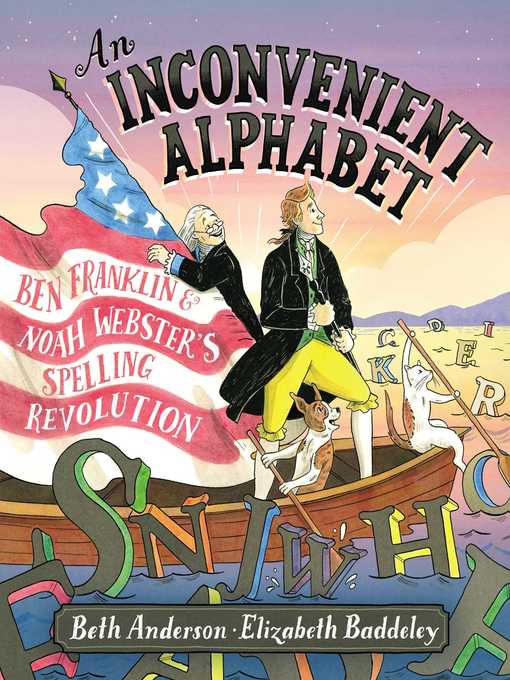
An Inconvenient Alphabet
Ben Franklin & Noah Webster's Spelling Revolution
فرمت کتاب
ebook
تاریخ انتشار
2018
Lexile Score
680
Reading Level
2-3
ATOS
3.9
Interest Level
K-3(LG)
نویسنده
Elizabeth Baddeleyشابک
9781534405561
کتاب های مرتبط
- اطلاعات
- نقد و بررسی
- دیدگاه کاربران
نقد و بررسی

July 1, 2018
Gr 2-4-Anderson builds on readers' familiarity with the American Revolution and Benjamin Franklin to deliver a lively account of how Franklin teamed up with Noah Webster to help create an English spelling system unique to people in the United States. There was much trial and error and many failed ideas around creating a new alphabet, with many of the concepts proposed facing strong criticism and outright rejection by the public. It was not until long after Franklin's death that Webster finally publish his first ever Compendious Dictionary of the English Language. The combination of bold illustrations, humorous anecdotes, and fabulous storytelling makes this true tale anything but boring. It provides a much-needed introduction to the art of spelling and dictionaries while remaining engaging and well paced. Despite discussing wordsmiths from over 200 years ago, Anderson delicately balances Franklin and Webster's dreams with grade-level appropriate vocabulary and readability. VERDICT The potentially dry topic of American English etymology is transformed into a delightful, relatable, and eye-catchingly illustrated tale that will have readers rooting for the success of the dictionary. Most collections will want to consider.-Emily Beasley, Omaha Public Schools
Copyright 2018 School Library Journal, LLC Used with permission.

July 15, 2018
Two Founding Fathers team up for their own miniature revolution--to simplify and standardize American English. Printer Ben Franklin couldn't stand inconsistent spelling. He wanted to invent some new and remove some old letters to create a phonetic alphabet. Noah Webster also couldn't stand our inconsistent alphabet. He wanted to create a guide to grammar and pronunciation. Both wanted to change the way that Americans used English: "Using twenty-six letters to write forty-four sounds caused nothing but trouble." The two visionaries teamed up to tackle the problem of the "inconvenient alphabet," crafting a new alphabet--one in which letters matched sounds and sounds matched letters. When this idea failed to gain widespread support, Webster came up with new plans, this time to revolutionize spelling. His plans for seemingly simpler spellings were also rejected by the populace, leading Webster to create his best-known work: his dictionary. Both Anderson's text and Baddeley's illustrations are energetic and compelling. The latter playfully elucidate examples of the linguistic nuances discussed, showing (for instance) Webster and Franklin manually taking silent letters out of words such as "walk" and "knock." The majority of illustrated figures are white, although a variety of skin tones are presented in each group illustration.Deelytful and iloominaating for noo and seesuned reeders alyk. (author's and illustrator's notes, quotation sources, bibliography) (Informational picture book. 5-8)
COPYRIGHT(2018) Kirkus Reviews, ALL RIGHTS RESERVED.

August 13, 2018
Anderson’s debut picture book details the origins of Noah Webster’s first American English dictionary and the struggles of Webster and Benjamin Franklin to help unify the new country through language in the 1780s. After laboring alone to streamline American English, the men meet and agree that the dawn of a new nation should also mean the dawn of a new kind of English for its citizens—one that would allow them to understand one another. “Some spoke like the king of England, others like backwoodsmen, and many barely spoke English at all.” The pair join forces over what proves a near-impossible task. Lighthearted illustrations by Baddeley (I Dissent: Ruth Bader Ginsberg Makes Her Mark) feature large, colorful letters that are juggled, balanced, passed around, and left in a crumpled heap as a befuddled citizenry questions and scorns the men’s proposals. Other touches, such as the changing expressions of the cameos hanging on Webster’s wall, keep the story engaging. With back matter that includes an extensive bibliography, this history succeeds in distilling the sophisticated subject of early American English lexicography into a comprehensible, lively read. Ages 4–8. Author’s agent: Stephanie Fretwell-Hill, Red Fox Literary. Illustrator’s agent: Alexandra Penfold, Upstart Crow.

August 1, 2018
Grades 1-3 Anyone learning to read and write English, whether as a first or second language, is struck by the inconsistencies involved. Letters make varying sounds. Spellings have rules that must be memorized. What people may not realize, however, is that Benjamin Franklin and Noah Webster teamed up in the early days of the U.S. to try to simplify such matters. Franklin developed a new alphabet with more specific sounds, while Webster advocated eliminating what he considered "unnecessary extras," such as silent letters. The illustrations, rendered using a mix of traditional and digital media as well as partially hand-lettered text, depict Franklin and Webster going about their business with large, three-dimensional alphabet letters bobbing around them like excited pets. Demonstrating perseverance, Franklin and Webster did not succeed completely in convincing others to adopt their point of view, but they did simplify some spellings, and Webster's dictionary was instrumental in making the language more consistent. An extensive bibliography and notes section details the work behind the scenes to make the book factual as well as entertaining.(Reprinted with permission of Booklist, copyright 2018, American Library Association.)

























دیدگاه کاربران